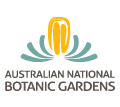 |
In Flower This WeekA weekly news-sheet prepared by a Gardens volunteerNumbers in brackets [ ] refer to garden bed 'Sections'. Plants in flower are in bold type. |
 |
In Flower This WeekA weekly news-sheet prepared by a Gardens volunteerNumbers in brackets [ ] refer to garden bed 'Sections'. Plants in flower are in bold type. |
23 November 2001
Because it is very windy this walk will be in areas with fewer trees to avoid the possibility of falling branches. To start, stroll through the flowers in the Tasmanian Garden where the colour of white, mostly of Ozothamnus species, seems to dominate. Crossing over the bridge, Ozothamnus expansifolius [Section 231] has many branches with a canopy of tiny cream flowers. Opposite, edging the water, Velleia montana [Section 232] is a small suckering ground-cover bright with yellow flowers. Close by Ozothamnus hookeri [Section 232] is a neat upright dwarf shrub with cream-green flowers blending with the foliage.
Rounding the curve, the much taller Ozothamnus ericifolius [Section 231] arranges its cream flowers in dense terminal clusters. Opposite, the bank has a scattering of a spreading suckering herb, Chrysocephalum apiculatum sens. lat. [Section 230] with small clusters of yellow ‘button’ flowers on upright stems. Above is Olearia ramulosa sens. lat. [Section 230], a rather straggly shrub clad with white daisies. Opposite the intersection, Odixia angusta [Section 230] has large heads of tightly packed small cream flowers. Between the rocks at the corner the Common Tussock Grass, Poa labillardieri [Section 233], is green and dense with purplish flower heads forever waving in the breeze. Past the next bridge and rounding the corner, Pelargonium australe [Section 237] is a dwarf, rounded herb with geranium shaped leaves and open-petalled flowers which are pale pink with purplish markings. Sunning on the rocks surrounding the pool could be a few Eastern Water Dragons, Physignathus lesuerii howittii. Then, behind the seat, Prostanthera lasianthos [Section 237] is a tall shrub laden with mauve bugle shaped flowers. Callistemon viridiflorus [Section 235], edging the small pool, is bright with deep lemon bottlebrush flowers.
Another area to visit is in front of the Crosbie Morrison Building, where Kangaroo Paw cultivars show the range of colours plant breeders have developed in this species. Anigozanthos ‘Bush Glow’ [Section 134] has bare upright stems of orange-red flowers and Anigozanthos ‘Bush Sunset’ [Section 242] has long upright stems of maroon flowers. Bordering this bed is Hibbertia elata [Section 242], a dwarf shrub glowing with yellow flowers. Chrysocephalum apiculatum sens. lat. [Section 242] differs from the species mentioned above, having felt-like grey foliage and large heads of yellow flowers. The far bed has a group of Anigozanthos manglesii [Section 199], the floral emblem of Western Australia, with really large ‘paw’ flowers coloured red and green.
Returning to the opposite corner above the retaining wall, Scaevola phlebopetala [Section 241] is a ground trailing plant with large, deep purple fan-shaped flowers with yellow throats. Nearby, Thomasia sp. [Section 241] is small and densely covered with dusky pink flowers while Lechenaultia biloba [Section 241] displays its lovely china blue flowers. At the corner of the Café building, Geraldton Wax, Chamelaucium uncinatum ‘Newmarracarra’ [Section 240], below the large eucalypt, is a dainty open shrub showing off its white and pink wax flowers.
Always another colourful corner to admire ... Barbara Daly.
Elizabeth Bilney
| Return to: | Australian National Botanic Gardens | Previous
'In Flower' Weeks |